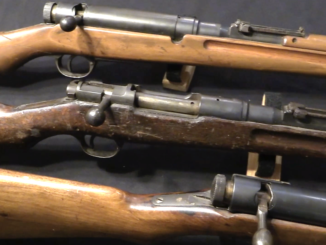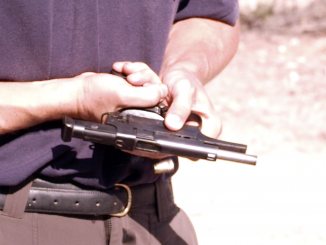Japanese Nambu pistols used to be widely ignored as inferior and uninteresting, but prices have been climbing in recent years (as with all Japanese wartime arms). As prices rise, it is beneficial have as much information as possible about the guns, to ensure you are getting the gun(s) you really want. Happily, there is an outstanding reference work on Japanese pistols available: Japanese Military Cartridge Handguns 1893-1945, by Harry L. Derby III and James D. Brown. It covers the two major Japanese WWII pistols – the Type 14 and Type 94 Nambus – is great detail, as well as having chapters on a bunch of much less-known handguns, including the “Grandpa”, “Papa”, and “Baby” Nambus, the Mark A experimental Nambu, Hamada, Hino-Komuro, Inagaki Shiki, North China Type 19, Sugiura Shiki, and a variety of flare pistols.
This book really is the one-stop shop for Japanese pistol information – nothing else I’ve seen comes close to matching it.
However, if this volume is simply a lot more information than you want, I would suggest James Brown’s abridged version, Collector’s Guide to Imperial Japanese Handguns. It is about a third the price, with about a fifth of the content (see our review of it).




Japaneese pistols, are remarkely good workmannship, and are nice in a collection.
I like them
Like the general spectrum of firearms offered by any nation in a given time period, Japanese firearms are a mixed bag — some outstanding, some mediocre, and most somewhere in between. To compound the issue further, some otherwise inferior weapons may have certain outstanding features that could be developed to further advantage, while some superior ones may have design issues that need to be rectified. Once in a while, a truly superior weapon incorporating mostly advantageous features and few, if any, faulty ones, comes to the fore. Then there are the additional uncertainties of market and historical timing, ammunition performance ( after all, a gun is of little use without good, reliable, effective ammunition ), end-user perceptions and a host of other circumstances that can bog down an otherwise exceptional firearm or, conversely, promote an unsatisfactory one.
Ian, I was just thinking — has Teri from Nambu World considered writing her own compendium on Japanese small arms? With her level of in-depth, practical knowledge and deductive reasoning, such a publication would probably be truly outstanding. On the other hand, I might have entirely missed the fact that she has already done so.
Hi-
Thank you for the kind endorsement. I do plan on writing a whole series of books after I retire (probably two years from now). Unfortunately the time demands of my job and family situation prevent me from pursuing this at the moment.
Thanks,
Teri
You’re quite welcome, Teri, and thank you for being so generous in writing back. It’s perfectly understandable that family and career should take first priority, and no-one would expect otherwise.
We’ll be looking forward to as and when you decide to put your thoughts and your storehouse of knowledge into print. In the meantime, I’d like to wish you all the very best in the time to come.
Yours Sincerely,
Earl Liew
Teri, I was wondering if you have a contact. I have just started researching a rifle left to me by my father, who got it from his dad. Thanks to your site, i have deduced it to be a Murata Type 18 but would like to know more about it. It seems to have some qualities that aren’t like the Type 18’s I’ve seen in your Nambu site, such as a much shorter forestock, and no bayonet lug or cleaning rod. I had the inscriptions translated by my judo teacher and she was on point with your indication ofn your site. I just want more help figuring this thing out. Thanks for any help you can lend.
Very thorough looking book. It too joins the ever growing list…
Splendid review, Ian. We currently offer this book on our website, abramsantiques.com, along with hundreds of other militaria and firearms reference books.